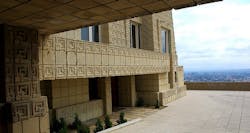The documentary Los Angeles Plays Itself is a fascinating look at how Hollywood has treated L.A. over the years. The film was made in 2003 but has just now become available on DVD, no doubt due to the cumbersome copyright issues that filmmaker Thom Andersen had to overcome. It’s almost entirely comprised of film clips, accompanied by commentary from a curmudgeonly narrator who sounds a lot like Billy Bob Thornton, but could be Andersen himself.
Part of the film deals with Hollywood’s treatment of modern architecture, including Frank Lloyd Wright’s Ennis House (featured in Blade Runner, and shown in the photo above) and Richard Neutra’s Lovell House (L.A. Confidential). The narrator maintains that such movies practically demonize the architecture, with camera angles, lighting, and set design that make it seem dark, cold, and forbidding. One tracking shot of the Lovell House’s massive horizontal beam is suggestive of a concrete prison.
Movies can also elevate and showcase architecture. In A Summer Place, a 1959 Troy Donahue film, the beach house purported to be on the coast of Maine is actually a Frank Lloyd Wright-designed home in Carmel, Calif. The owner proudly name-drops FLW in a line of dialogue.
Even homes that don’t really exist except in the filmmaker’s imagination can make a strong impression. For years, I thought the house in Alfred Hitchcock’s North by Northwest (1958) was real. It turns out that Hitchcock wanted Wright to design and build a house for the movie, but couldn’t afford the architect’s fee. Instead, the interiors were shot on elaborate sets constructed on the MGM lot. The exteriors were created by a very talented special-effects department. Too bad it’s not a house one can actually visit. But what an incredible work of movie fiction!
Getting back to Los Angeles Plays Itself, there’s more to the film than famous houses. Andersen also touches on various iconic structures, restaurants, nightclubs, and neighborhoods, with biting social commentary along the way. It’s funny and entertaining, even if you’re not an architecture buff. Try to catch it either on DVD or Netflix.
About the Author

Susan Bady
Susan Bady has been writing about the housing industry for 30 years. She is senior editor of Professional Builder and Custom Builder magazines, and produces the Design Innovation e-newsletter. Bady has also written for such consumer magazines as Cabin Life and Better Homes and Gardens’ Home Plan Ideas.
